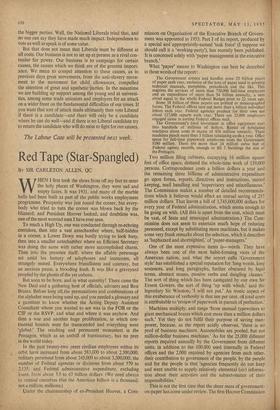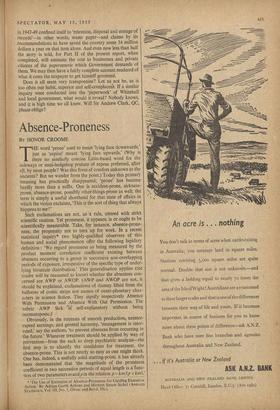Red Tape (Star-Spangled)
WHEN I first took the shoes from off my feet to enter the holy places of Washington, they were sad and empty faces. It was 1931. and many of the marble halls had been built as part of the public works employment programme. Prosperity was just round the corner, but every- body who tried to turn the corner was blown back by the blizzard; and President Hoover looked, and doubtless was, one of the most worried men I have ever seen.
To reach a High Up, one was conducted through re-echoing corridors, then into a vast antechamber where, half-hidden in a corner, a Lower Down was busily trying to look busy, then into a smaller antecha\mber where an Efficient Secretary was doing the same with rather more accomplished charm. Then into the presence itself, where the affable personage sat amid his battery of telephones and intercoms, all strangely muted. Everywhere friendliness and courtesy, but an anxious pause, a brooding hush. It was like a graveyard peopled by the ghosts of the yet unborn.
But soon to be born. and in what quantity! There came the New Deal and a gathering host of officials, advisers and Best Brains. Before long all. the permutations and combinations of the alphabet were being used up. and you needed a glossary and a gazetteer to know whether the Acting Deputy Assistant Consultant whom you wanted to see was in the FOB or the CIF or the RSVP, and what and where it was anyhow. And then a war and another huge proliferation, in which con- tinental bounds were far transcended and everything went `global.' The resulting and permanent monument is the Pentagon. which as an anthill of bureaucracy, has no peer in the world today. mission on Organisation of the Executive Branch of Govern- ment was appointed in 1953. Part. I of its report, produced by a special and appropriately-named 'task force' (I suppose we should call it a 'working-party'), has recently been published. It is concerned solely with 'paper management in the executive branch.'
What 'paper' means to Washington can best be described in these words of the report:
The Government creates and handles sonic 25 billion pieces of paper each year. exclusive of the tons of paper used in printing technical manuals, pamphlets, periodicals and the like. This requires the services of more than 750,000 full-time employees and an expenditure of more than $4 billion annually, a sum about equal to the whole Federal Budgetk prior to 22 years ago. Some 18 billion of these papers are printed or mimeographed forms. The Federal offices turn out more than a billion individual letters each year. Federal agencies produce for their own use about 127,000 reports each year. There arc 25,000 employees engaged alone in sorting Federal offices mail.
The Government's total investment in office equipment runs into hundreds of millions of dollars. Rental of tabulating machines alone costs in excess of $36 million annually. These machines punch more than 5 billion tabulating cards a year. Office space for full-time paperwork employees costs the Government $180 million. There are more than 24 million cubic feet of Federal agency records, enough to fill 7 buildings the size of the Pentagon.
Two million filing cabinets, occupying 16 million square feet of office space, demand the whole-time work of 159.000 persons. Correspondence costs a billion dollars a year and the remaining three billions of administrative expenditure go upon forms, reports, directives and instructions, record keeping, mail handling and 'supervisory and miscellaneous.' The Commission makes a number of detailed recommenda- tions which it believes would effect an annual saving of 255 million dollars. That leaves a bill of 3.745,000,000 dollars for every year of Federal administration, which seems enough to be going on with. (All this is apart from the cost, which must be vast, of State and municipal administration.) The Com- mission does not seem to entertain much hope of reducing personnel, except by substituting more machines. but it makes some very frank remarks about the selection, which it describes as 'haphazard and shortsighted.' of 'paper-managers.' in 1947-49 confined itself to 'retention, disposal and storage of records'—in other words, waste paper—and claims by its recommendations to have saved the country some 34 million dollars a year on that item alone. And even now less than half the story is told, for Part II of the present report, when completed, will estimate the cost to businesses and private citizens of the paperasserie which Government demands of them. We may then have a fairly complete account rendered of what it costs the taxpayer to get himself governed.
Does it all seem very transpontine? Let us not be, as is too often our habit, superior and self-complacent. If a similar inquiry were conducted into the 'paperwork' of Whitehall and local government, what would it reveal? Nobody knows, and it is high time we all knew. Will Sir Andrew Clark, QC, please oblige?



































 Previous page
Previous page